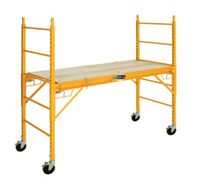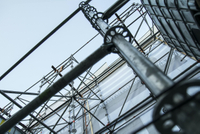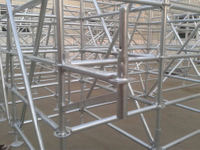Content Menu
● What Is Versatile Ringlock Scaffolding?
● Key Features of Versatile Ringlock Scaffolding
● Why Is Versatile Ringlock Scaffolding Ideal for Industrial Use?
>> 1. Unmatched Versatility and Adaptability
>> 2. Superior Strength and Safety
>> 3. Speed and Efficiency
>> 4. Cost-Effectiveness
>> 5. Compliance and Certification
● Comparing Ringlock Scaffolding to Other Systems
● Industrial Applications: Real-World Use Cases
>> Oil & Gas Sector
>> Power Generation
>> Chemical and Manufacturing Plants
>> Shipbuilding and Maritime
>> Mining and Heavy Industry
● Step-by-Step: How to Assemble Ringlock Scaffolding
● Advantages of Versatile Ringlock Scaffolding in Industrial Settings
● Common Mistakes to Avoid in Industrial Use
● Best Practices for Maximizing the Benefits of Ringlock Scaffolding
>> 1. Conduct Thorough Site Assessments
>> 2. Train Workers on Assembly and Safety
>> 3. Implement Regular Inspections
>> 4. Use the Right Accessories
>> 5. Plan for Efficient Dismantling and Storage
● Environmental and Sustainability Considerations
● Case Study: Versatile Ringlock Scaffolding in a Petrochemical Plant
● Future Trends: Digital Integration and Smart Scaffolding
● Conclusion
● FAQ
>> 1. What makes versatile ringlock scaffolding different from other scaffolding systems?
>> 2. Is ringlock scaffolding safe for use in hazardous industrial environments?
>> 3. Can ringlock scaffolding be used for both maintenance and new construction in industrial plants?
>> 4. How does ringlock scaffolding save time and money in industrial projects?
>> 5. What maintenance is required for ringlock scaffolding in industrial use?
Versatile ringlock scaffolding has become a cornerstone of modern construction and industrial maintenance, prized for its adaptability, strength, and efficiency. But is it truly suitable for the demanding environments of industrial applications? This comprehensive guide explores the features, benefits, and real-world uses of versatile ringlock scaffolding in industrial settings, providing detailed insights and expert answers to frequently asked questions.
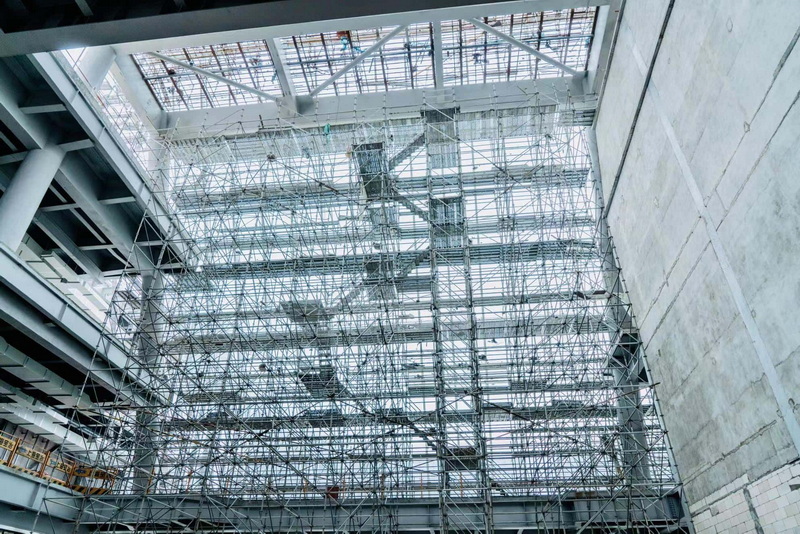
What Is Versatile Ringlock Scaffolding?
Ringlock scaffolding is a modular system built from high-strength steel components, featuring vertical standards with welded rosettes (rings) at fixed intervals. These rings allow for the rapid connection of horizontal ledgers, diagonal braces, and other accessories at multiple angles, creating a stable and highly customizable structure. The system is designed for quick assembly and dismantling, making it ideal for projects where time and adaptability are critical.
Key Features of Versatile Ringlock Scaffolding
- Modular Design: Components can be mixed and matched to fit unique project requirements, from straight runs to complex curves and corners.
- High Load-Bearing Capacity: Engineered for strength, it supports heavy materials, equipment, and multiple workers simultaneously.
- Quick Assembly and Disassembly: The wedge-head locking mechanism allows for tool-free, efficient setup, reducing labor costs and project timelines.
- Durability: Hot-dip galvanized steel resists corrosion and withstands harsh industrial environments.
- Safety: Secure connections, anti-slip platforms, and integrated guardrails enhance worker protection at height.
Why Is Versatile Ringlock Scaffolding Ideal for Industrial Use?
1. Unmatched Versatility and Adaptability
Ringlock scaffolding's modular nature allows it to conform to virtually any structure-straight, curved, or multi-level. This adaptability is crucial in industrial settings, where access needs can change rapidly, and workspaces often feature complex geometries.
- Examples of Industrial Adaptation:
- Refineries and Power Plants: Access to boilers, turbines, and cooling towers.
- Chemical Plants: Safe platforms for elevated installations and maintenance.
- Manufacturing Facilities: Flexible arrangements around machinery for repairs and inspections.
- Shipyards: Scaffolding adapts to hull curves and confined spaces.
- Mining and Utilities: Durable enough for harsh, uneven terrains and large structures.
2. Superior Strength and Safety
Industrial environments demand scaffolding that can handle heavy loads and provide stable platforms for workers and equipment. Ringlock scaffolding's robust steel construction and secure locking mechanisms ensure stability, even under significant weight and in hazardous conditions.
- High Load Capacity: Supports workers, tools, and materials without compromising structural integrity.
- Safety Features: Integrated guardrails, anti-slip surfaces, and secure locking prevent accidents and meet strict safety regulations.
3. Speed and Efficiency
Time is money in industrial operations. Ringlock scaffolding's rapid assembly and dismantling minimize downtime during plant shutdowns, maintenance, or equipment installation. The system's intuitive connections mean fewer components and less labor, streamlining workflows and reducing costs.
4. Cost-Effectiveness
Despite a higher initial investment compared to some traditional systems, ringlock scaffolding's long-term savings are significant:
- Reduced Labor Costs: Fewer components and faster assembly translate to lower labor expenses.
- Durability: Galvanized steel components last longer, reducing replacement costs.
- Reusability: Modular parts can be reconfigured for different projects, maximizing return on investment.
5. Compliance and Certification
Leading ringlock systems are tested and certified to meet international safety and quality standards, making them suitable for regulated industrial environments worldwide.
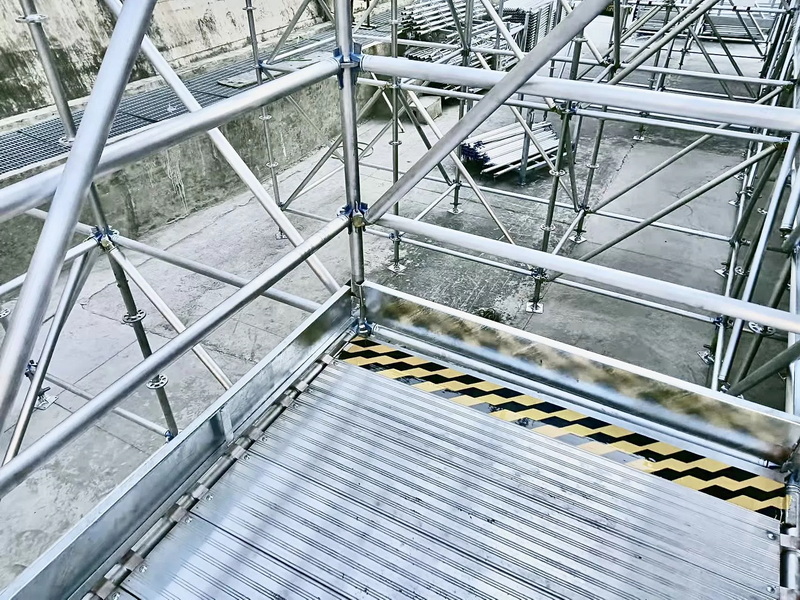
Comparing Ringlock Scaffolding to Other Systems
| Feature | Ringlock Scaffolding | Tube & Clamp | Frame Scaffolding |
| Assembly Speed | Fast, tool-free | Slow, requires clamps/tools | Fast for simple structures |
| Versatility | High-adapts to complex shapes | Very high, but laborious | Low-best for simple layouts |
| Load Capacity | Very high | Moderate | Low to moderate |
| Safety | Integrated, robust | Depends on assembly | Basic |
| Cost (Long-Term) | Cost-effective | Higher labor costs | Economical for small jobs |
| Industrial Suitability | Excellent | Good, but slower | Limited |
Industrial Applications: Real-World Use Cases
Oil & Gas Sector
Ringlock scaffolding is widely used for maintenance, shutdowns, and construction in refineries and offshore platforms. Its high load capacity and modularity allow safe access to reactors, distillation columns, and storage tanks, even in confined or hazardous environments.
Power Generation
Power plants require regular maintenance of boilers, turbines, and cooling towers. Ringlock scaffolding's adaptability and strength make it the preferred choice for these high-risk, high-load tasks.
Chemical and Manufacturing Plants
Complex piping, elevated machinery, and frequent layout changes are common in these facilities. The modular design of ringlock scaffolding enables quick reconfiguration, ensuring safe and efficient access for repairs and inspections.
Shipbuilding and Maritime
Shipyards benefit from ringlock scaffolding's ability to create platforms on sloped or curved surfaces, essential for hull repairs and upgrades.
Mining and Heavy Industry
Durability is critical in mining, where scaffolding must withstand harsh conditions and support heavy equipment. Ringlock scaffolding's robust construction and corrosion resistance make it ideal for both underground and above-ground operations.
Step-by-Step: How to Assemble Ringlock Scaffolding
Assembly diagram showing the main components of a ringlock scaffolding system.
Basic Steps:
1. Prepare the Foundation: Ensure a stable, level base using adjustable base jacks and sole boards.
2. Install Vertical Standards: Place standards at designated intervals, connecting base collars and rosettes.
3. Add Ledgers and Diagonals: Attach horizontal ledgers and diagonal braces to the rosettes, securing with wedge-heads for stability.
4. Build Platforms: Place steel planks or decks for worker access, securing with toe boards and guardrails.
5. Inspect and Secure: Check all connections, locking pins, and safety features before use.
Advantages of Versatile Ringlock Scaffolding in Industrial Settings
- Supports Heavy Loads: Suitable for masonry, mechanical supports, and equipment platforms.
- Adapts to Complex Structures: Easily configured for tanks, silos, spheres, and irregular layouts.
- Minimizes Downtime: Rapid assembly/dismantling accelerates maintenance and turnaround operations.
- Enhances Worker Safety: Integrated guardrails, anti-slip surfaces, and secure connections reduce accident risks.
- Reduces Labor and Material Costs: Fewer components and faster setup save money over time.
- Resists Corrosion: Galvanized steel components withstand harsh industrial environments.
- Complies with Regulations: Certified to meet international safety standards for industrial use.
Common Mistakes to Avoid in Industrial Use
- Improper Foundation Preparation: Always use solid, level bases and appropriate base jacks.
- Overloading: Never exceed the scaffold's rated capacity; calculate total load before use.
- Incorrect Assembly: Follow manufacturer instructions, install all braces, and stagger joints for stability.
- Missing or Loose Pins: Inspect and secure all locking pins and couplers before use.
- Inadequate Safety Features: Ensure guardrails, toe boards, and safe access are in place at all times.
Best Practices for Maximizing the Benefits of Ringlock Scaffolding
To fully leverage the advantages of versatile ringlock scaffolding in industrial environments, it's important to implement best practices in planning, assembly, and maintenance:
1. Conduct Thorough Site Assessments
Before installation, evaluate the worksite for ground stability, access points, overhead obstructions, and environmental hazards. Customizing the scaffold layout based on these factors ensures both safety and efficiency.
2. Train Workers on Assembly and Safety
Proper training is essential. Workers should be familiar with the specific components of versatile ringlock scaffolding, understand load ratings, and be able to identify and address potential safety risks during assembly and use.
3. Implement Regular Inspections
Routine inspections before each shift can identify worn or damaged components, loose connections, or missing safety features. Promptly addressing these issues prevents accidents and extends the lifespan of the scaffolding system.
4. Use the Right Accessories
Versatile ringlock scaffolding supports a variety of accessories such as stairways, ladders, cantilever brackets, and mesh safety panels. Selecting the right accessories for each task enhances both productivity and worker protection.
5. Plan for Efficient Dismantling and Storage
Efficient dismantling and organized storage of components reduce the risk of loss or damage and ensure that the system is ready for quick redeployment on future projects.
Environmental and Sustainability Considerations
Industrial companies are increasingly focused on sustainability. Versatile ringlock scaffolding supports these goals in several ways:
- Reusability: Components can be used repeatedly across multiple projects, reducing waste.
- Recyclability: Steel components are fully recyclable at the end of their service life.
- Reduced Transport Costs: The modular, stackable design allows for efficient transport, lowering fuel consumption and emissions.
- Minimal Site Impact: Quick assembly and disassembly minimize disruption to sensitive environments.
Case Study: Versatile Ringlock Scaffolding in a Petrochemical Plant
In a recent maintenance shutdown at a large petrochemical facility, versatile ringlock scaffolding was selected for its adaptability and speed. The project required access to multiple levels of piping, storage tanks, and confined spaces, all within a tight schedule. The modular design allowed for rapid assembly around complex structures, while integrated safety features ensured compliance with strict plant regulations. As a result, the maintenance was completed ahead of schedule, with zero safety incidents and significant cost savings compared to previous shutdowns using traditional scaffolding.
Future Trends: Digital Integration and Smart Scaffolding
The future of versatile ringlock scaffolding in industrial use is being shaped by digital innovation:
- BIM Integration: Building Information Modeling (BIM) enables precise planning and visualization of scaffold layouts, reducing errors and optimizing material usage.
- IoT Sensors: Smart scaffolding systems are being developed with sensors that monitor load, vibration, and environmental conditions in real time, enhancing safety and maintenance.
- Augmented Reality (AR): AR tools assist workers in assembly, inspection, and training, further improving efficiency and reducing the risk of mistakes.
These advancements promise to make versatile ringlock scaffolding even more indispensable in the industrial sector.
Conclusion
Versatile ringlock scaffolding is not only suitable but is often the preferred choice for industrial use. Its modular design, high load-bearing capacity, rapid assembly, and exceptional adaptability make it ideal for the complex, demanding environments found in power plants, refineries, chemical plants, shipyards, and more. With integrated safety features and compliance with international standards, ringlock scaffolding delivers both performance and peace of mind for industrial operators. When properly assembled and maintained, it enhances productivity, reduces downtime, and safeguards workers-making it an indispensable tool for modern industry.
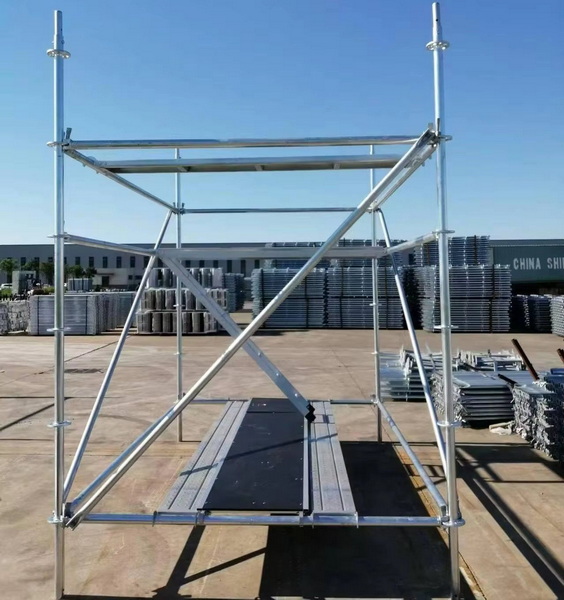
FAQ
1. What makes versatile ringlock scaffolding different from other scaffolding systems?
Ringlock scaffolding features a modular design with rosettes at fixed intervals, allowing for quick, tool-free assembly and flexible configurations. It supports complex geometries and heavy loads, unlike traditional tube and clamp or frame scaffolding.
2. Is ringlock scaffolding safe for use in hazardous industrial environments?
Yes. Its robust construction, secure locking mechanisms, and integrated safety features such as guardrails and anti-slip platforms make it highly suitable for hazardous industrial settings like refineries, power plants, and chemical facilities.
3. Can ringlock scaffolding be used for both maintenance and new construction in industrial plants?
Absolutely. Its adaptability allows it to be reconfigured for maintenance, repairs, inspections, and new construction projects, even in confined or complex spaces.
4. How does ringlock scaffolding save time and money in industrial projects?
The system's quick assembly and dismantling reduce labor costs and project timelines. Its durability and reusability minimize long-term expenses, and fewer components mean lower material and transport costs.
5. What maintenance is required for ringlock scaffolding in industrial use?
Regular inspections for damage, corrosion, and loose connections are essential. Components should be cleaned, stored dry, and replaced if worn or damaged to ensure ongoing safety and performance.













